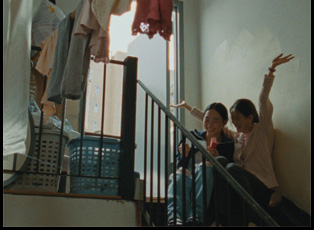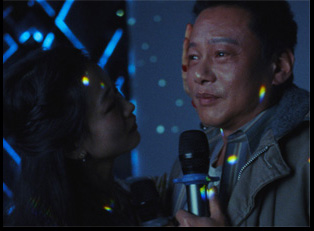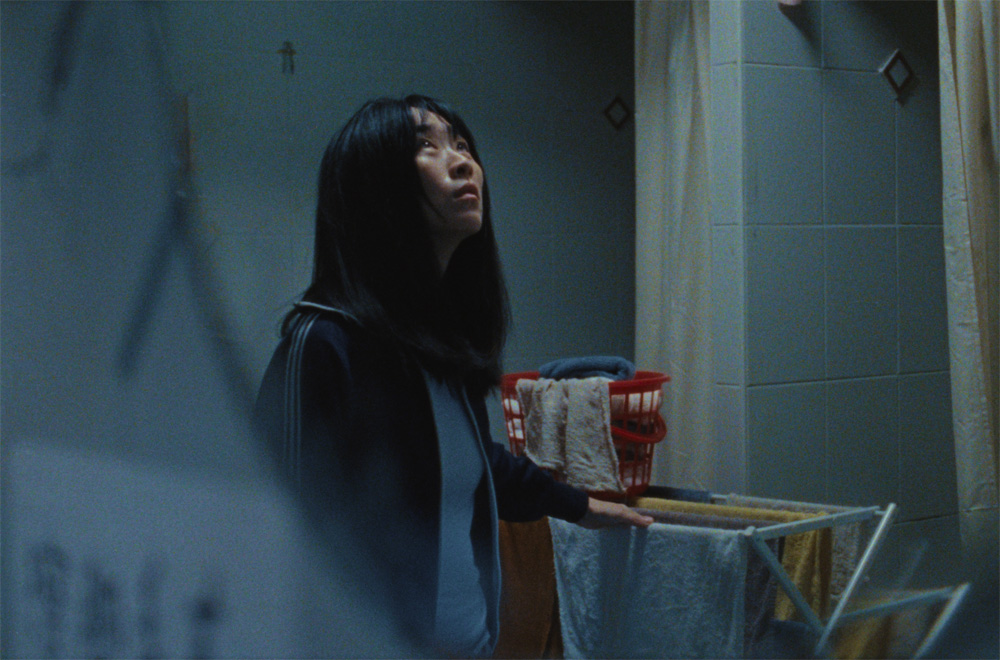Ke-Xi Wu did plenty of research before stepping into the role of Amy, a lonely immigrant who fears she’s fallen into the cracks between two worlds as she works at a massage parlor in the Chinese-American enclave of Flushing, New York in “Blue Sun Palace.” However, she found she only needed to look to her director Constance Tsang – quite literally – to get an idea of how to play the part.
“Something interesting about this role is that before I started to prepare, I was doing the [costume] fitting and then that day, I remember I started to feel like, “Oh my God, am I wearing Constance’s clothes?,” Wu said recently. “At that moment, I [thought], I need to observe [Constance] more because Amy is really her in some way and I don’t know why, but I just started to imitate her, some of her gestures…”
“This is news to me,” Tsang says, with a laugh and a raised eyebrow as Wu continues on about how she might’ve taken some unexpected inspiration from the filmmaker.
Maybe the actress was exaggerating slightly when Tsang based “Blue Sun Palace” only on her own deep research of the community depicted in the film, having grown up in the area yet having no direct ties to the material, but there is something both singular and ineffable at work in her soulful debut feature that suggests a wavelength that the director carried around that Wu was wise to tap into. Moving gracefully through the experience of channeling life on the margins, the film only gradually brings Amy into the center of the frame after her colleague Didi (Haipeng Xu) is the victim of a shocking incident at the parlor, leaving Amy with the fear that something similar could happen to her as well as the grief that lingers from the loss of her friend. The latter she finds she is able to share to some degree with Cheung (Kang-sheng Lee), a man Didi was seeing at the time of her death and could envision a future with.
The presence of Lee, a veteran of Tsai Ming-Liang productions, might tip off Tsang’s influences as “Blue Sun Palace” is patient and meticulous in detail, but finds its own form of dynamism as the emotions constantly stirring inside Amy have a way of expressing themselves in the environment around her and working with cinematographer Norm Li (“Seagrass” and “The Body Remembers When the World Broke Open”), the director creates static frames that always have plenty going on inside even if it’s merely capturing a character alone with their thoughts in a room. An overwhelming feeling of grief may pervade the drama, but as Amy and Cheung start to engage with one another and assert themselves more in a world they never felt entirely comfortable in in the first place, the film offers a similar sensation of transcendence for audiences as it does for those on screen.
After first premiering around this time last year at Cannes, “Blue Sun Palace” is now arriving in U.S. theaters and when Wu and Tsang recently accompanied the film to its bow at New Directors/New Films, they graciously took the time to talk about their collaboration, achieving the long takes that do their part to make the film so engrossing and how Wu found energy to draw on all around her from what was going on outside the production.
 How did this take shape as a story?
How did this take shape as a story?
Constance Tsang: The whole writing process took about five years to have the story move from the first iterations, which was very different to the film that we’re watching. During that time, I had experienced, of course, COVID and I also had a long-term relationship ended and I think I felt finally ready to talk about losing my father and the grief that kind of came with it, so it really was a long journey to what we’re watching now.
Ke-Xi, what got you excited about this?
Ke-Xi Wu: I’ve played immigrants in many films, and that’s why when I first read the script, I felt familiar with the immigration story. But then it [was set] in the U.S. and it was from a female’s point of view and I really wanted to work with a female director and to experience shooting in the U.S. [Constance and I] chatted a lot the first time we met, and I happened to have a similar grieving story as well. I lost someone, so I can wrestle with that as the character and also understand her feelings. Then as we started to work, I needed to learn the whole massage skill from the masseuses and then to work at a restaurant. I also visited the 9/11 Museum and walk around New York City to try to experience what Amy’s feeling and then try to understand what her fear is and why she wanted to stay here no matter what happens. So day by day, that’s how I realized how to play her.
This plays out in long takes that really pull you into the experience, but they must’ve been difficult to prepare for. What was it like to actually work on and find a rhythm?
Ke-Xi Wu: Yeah, I really love these long takes because I felt grieving is something that takes a long time for people to get over. Most of the time, it never goes away and while I was playing with these long takes, like with real time, it really gave me as Amy a very emotional feeling while I was doing the massage and some of that, so it really helped the character.
Constance Tsang: In terms of rhythm, what was important when looking at the overall architecture of the film was that the rhythm of the performances also matched the tone of the filmmaking. That’s a credit to the way that Ke-xi and also Kang-sheng [Lee] understood the story and what tone I was trying to go for.
That early scene in the stairwell, there is so much going on that sets the tone for the film, not only in terms of exposition, but the general feeling of it as Amy and Didi speak and life carries on around them. What was that day like?
Ke-Xi Wu: That scene is very interesting to me because this character really is fond of Didi, but there’s some jealousy and the tragedy still hasn’t happened yet. So I wanted to be happier and try to build this relationship. We became very good friends before we shot this film, so when we actually shot it, everything becomes so natural.
Constance Tsang: Yeah, Hai Peng Xu, the actress that plays Didi, is incredible and her energy is just so infectious. It really is and it was just so natural watching them respond to each other. [All the women at the parlor] were so fun. I love them so much. They were so incredibly giving and Murielle [Hsieh], who plays Josie in the film, it was her first time ever acting in a movie and it was just so wonderful to see her blossom and work. And to watch the actors [in general] was a little bit like watching magic unfold.
 The camera work is so engaged with the performances. Was it largely planned out before filming or was there room to be a bit intuitive on the day of filming?
The camera work is so engaged with the performances. Was it largely planned out before filming or was there room to be a bit intuitive on the day of filming?
Constance Tsang: I always know the form that I’m going to shoot the film in because it’s so interconnected. I don’t think you can write a script where it doesn’t use long takes. It wouldn’t synchronize for me. And with the camerawork, so much of it was a part of what I had imagined when I was writing the script and when Norm [Li, the director of photography] and I started talking to each other about the way that we would visualize it, we had an understanding of the camera language first, setting a blueprint for what we hope to shoot and of course, [you reconsider it] when you get to the space.
I spent so much time location scouting. I would location scout on my own and sometimes with my DP months before we shot the film to find the perfect location and we really stayed true to what the locations were giving us. It was never like we needed to fully recreate something that was not already given to us. It was our production designer accentuating and tweaking. Luckily, we were able to be in the spaces for a long time before we actually shot, so we understood it. What actually does change is where you put the camera, not necessarily the movement itself, but just where you decide to put it, so it was a combination of many things to find that filmic language.
Ke-Xi, was there anything that happened that changed your ideas about the character once you were on set?
Ke-Xi Wu: Yeah, I did all the research and preparation before shooting, but I didn’t know until maybe days before the shooting [or even] more recently, I tried to act in this way [where] I tried to find something more on set, to be more flexible and try to always find something. Was there anything better than I imagined? Was there anything more interesting that I hadn’t thought about before? That’s why, for example, in the restaurant scene, I didn’t expect to be so emotional, but days before [filming the scene], there was actually a robbery that happened near Flushing. Suddenly, I felt so scared and I started to question myself, “Okay, am I a princess in the palace or am I a prisoner in a cell,” being in this massage parlor. This environment was just giving me so many emotions, and little by little, that’s [how I developed how] I should play this.
What’s it been like to see this get out into the world?
Constance Tsang: It’s been really wonderful. I love all the opportunities to be able to show this film and it’s a beautiful experience for us to be able to have this small film have such a hold. It wasn’t something that when I was making the film I could have imagined for it, but I feel very, very grateful and really humbled by this experience.
Ke-Xi Wu: I didn’t expect that we would experience all this — I really love this kind of filmmaking, and this opportunity really came out of nowhere during a time when I was really trying to have something to break through. Because I shot many films with long takes and working with non-professionals, somehow it all came back together in this film and it made the filming on set go really smoothly and we shot the film within 18 days. It’s very intensive and you have to do it quickly, but I was so used to this, [shooting out scenes in only] one take felt like nothing. So I really love it and it was a lovely experience.
“Blue Sun Palace” opens on April 25th in New York at the Metrograph, Hartford, Connecticut at the Cinestudio and in Los Angeles at the Laemmle Glendale ahead of a nationwide run. A full schedule of theaters and dates is here.




